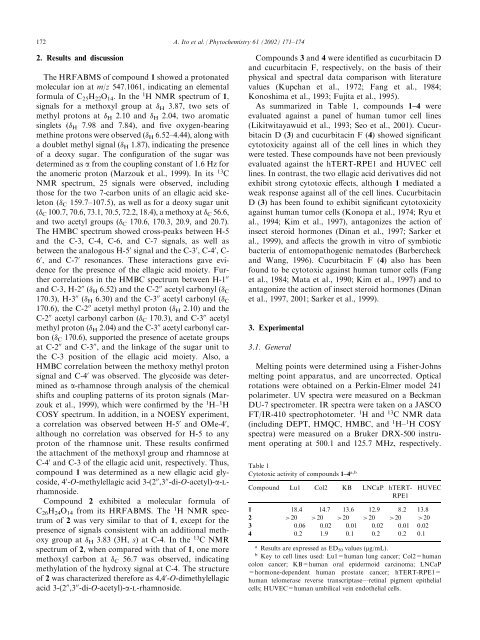Elaeocarpus mastersii
Elaeocarpus mastersii
Elaeocarpus mastersii
You also want an ePaper? Increase the reach of your titles
YUMPU automatically turns print PDFs into web optimized ePapers that Google loves.
172 A. Ito et al. / Phytochemistry 61 (2002) 171–174<br />
2. Results and discussion<br />
The HRFABMS of compound 1 showed a protonated<br />
molecular ion at m/z 547.1061, indicating an elemental<br />
formula of C 25H 22O 14.In the 1 H NMR spectrum of 1,<br />
signals for a methoxyl group at H 3.87, two sets of<br />
methyl protons at H 2.10 and H 2.04, two aromatic<br />
singlets ( H 7.98 and 7.84), and five oxygen-bearing<br />
methine protons were observed ( H 6.52–4.44), along with<br />
a doublet methyl signal ( H 1.87), indicating the presence<br />
of a deoxy sugar.The configuration of the sugar was<br />
determined as a from the coupling constant of 1.6 Hz for<br />
the anomeric proton (Marzouk et al., 1999). In its 13 C<br />
NMR spectrum, 25 signals were observed, including<br />
those for the two 7-carbon units of an ellagic acid skeleton<br />
( C 159.7–107.5), as well as for a deoxy sugar unit<br />
( C 100.7, 70.6, 73.1, 70.5, 72.2, 18.4), a methoxy at C 56.6,<br />
and two acetyl groups ( C 170.6, 170.3, 20.9, and 20.7).<br />
The HMBC spectrum showed cross-peaks between H-5<br />
and the C-3, C-4, C-6, and C-7 signals, as well as<br />
between the analogous H-5 0 signal and the C-3 0 ,C-4 0 ,C-<br />
6 0 , and C-7 0 resonances.These interactions gave evidence<br />
for the presence of the ellagic acid moiety.Further<br />
correlations in the HMBC spectrum between H-1 00<br />
and C-3, H-2 00 ( H 6.52) and the C-2 00 acetyl carbonyl ( C<br />
170.3), H-3 00 ( H 6.30) and the C-3 00 acetyl carbonyl ( C<br />
170.6), the C-2 00 acetyl methyl proton ( H 2.10) and the<br />
C-2 00 acetyl carbonyl carbon ( C 170.3), and C-3 00 acetyl<br />
methyl proton ( H 2.04) and the C-3 00 acetyl carbonyl carbon<br />
( C 170.6), supported the presence of acetate groups<br />
at C-2 00 and C-3 00 , and the linkage of the sugar unit to<br />
the C-3 position of the ellagic acid moiety.Also, a<br />
HMBC correlation between the methoxy methyl proton<br />
signal and C-4 0 was observed.The glycoside was determined<br />
as a-rhamnose through analysis of the chemical<br />
shifts and coupling patterns of its proton signals (Marzouk<br />
et al., 1999), which were confirmed by the 1 H– 1 H<br />
COSY spectrum.In addition, in a NOESY experiment,<br />
a correlation was observed between H-5 0 and OMe-4 0 ,<br />
although no correlation was observed for H-5 to any<br />
proton of the rhamnose unit.These results confirmed<br />
the attachment of the methoxyl group and rhamnose at<br />
C-4 0 and C-3 of the ellagic acid unit, respectively.Thus,<br />
compound 1 was determined as a new ellagic acid glycoside,<br />
4 0 -O-methylellagic acid 3-(2 00 ,3 00 -di-O-acetyl)-a-lrhamnoside.<br />
Compound 2 exhibited a molecular formula of<br />
C26H24O14 from its HRFABMS.The 1 H NMR spectrum<br />
of 2 was very similar to that of 1, except for the<br />
presence of signals consistent with an additional methoxy<br />
group at H 3.83 (3H, s) at C-4.In the 13 CNMR<br />
spectrum of 2, when compared with that of 1, one more<br />
methoxyl carbon at C 56.7 was observed, indicating<br />
methylation of the hydroxy signal at C-4.The structure<br />
of 2 was characterized therefore as 4,4 0 -O-dimethylellagic<br />
acid 3-(2 00 ,3 00 -di-O-acetyl)-a-l-rhamnoside.<br />
Compounds 3 and 4 were identified as cucurbitacin D<br />
and cucurbitacin F, respectively, on the basis of their<br />
physical and spectral data comparison with literature<br />
values (Kupchan et al., 1972; Fang et al., 1984;<br />
Konoshima et al., 1993; Fujita et al., 1995).<br />
As summarized in Table 1, compounds 1–4 were<br />
evaluated against a panel of human tumor cell lines<br />
(Likitwitayawuid et al., 1993; Seo et al., 2001). Cucurbitacin<br />
D (3) and cucurbitacin F (4) showed significant<br />
cytotoxicity against all of the cell lines in which they<br />
were tested.These compounds have not been previously<br />
evaluated against the hTERT-RPE1 and HUVEC cell<br />
lines.In contrast, the two ellagic acid derivatives did not<br />
exhibit strong cytotoxic effects, although 1 mediated a<br />
weak response against all of the cell lines.Cucurbitacin<br />
D(3) has been found to exhibit significant cytotoxicity<br />
against human tumor cells (Konopa et al., 1974; Ryu et<br />
al., 1994; Kim et al., 1997), antagonizes the action of<br />
insect steroid hormones (Dinan et al., 1997; Sarker et<br />
al., 1999), and affects the growth in vitro of symbiotic<br />
bacteria of entomopathogenic nematodes (Barbercheck<br />
and Wang, 1996).Cucurbitacin F (4) also has been<br />
found to be cytotoxic against human tumor cells (Fang<br />
et al., 1984; Mata et al., 1990; Kim et al., 1997) and to<br />
antagonize the action of insect steroid hormones (Dinan<br />
et al., 1997, 2001; Sarker et al., 1999).<br />
3. Experimental<br />
3.1. General<br />
Melting points were determined using a Fisher-Johns<br />
melting point apparatus, and are uncorrected.Optical<br />
rotations were obtained on a Perkin-Elmer model 241<br />
polarimeter.UV spectra were measured on a Beckman<br />
DU-7 spectrometer.IR spectra were taken on a JASCO<br />
FT/IR-410 spectrophotometer. 1 H and 13 C NMR data<br />
(including DEPT, HMQC, HMBC, and 1 H– 1 HCOSY<br />
spectra) were measured on a Bruker DRX-500 instrument<br />
operating at 500.1 and 125.7 MHz, respectively.<br />
Table 1<br />
Cytotoxic activity of compounds 1–4 a,b<br />
Compound Lu1 Col2 KB LNCaP hTERT-<br />
RPE1<br />
HUVEC<br />
1 18.4 14.7 13.6 12.9 8.2 13.8<br />
2 >20 >20 >20 >20 >20 >20<br />
3 0.06 0.02 0.01 0.02 0.01 0.02<br />
4 0.2 1.9 0.1 0.2 0.2 0.1<br />
a Results are expressed as ED50 values (mg/mL).<br />
b Key to cell lines used: Lu1=human lung cancer; Col2=human<br />
colon cancer; KB=human oral epidermoid carcinoma; LNCaP<br />
=hormone-dependent human prostate cancer; hTERT-RPE1=<br />
human telomerase reverse transcriptase—retinal pigment epithelial<br />
cells; HUVEC=human umbilical vein endothelial cells.




